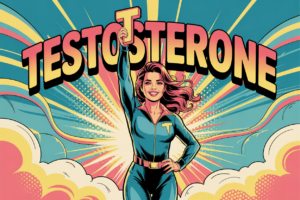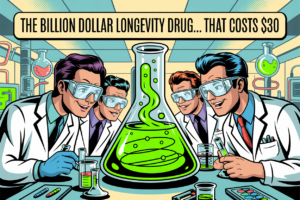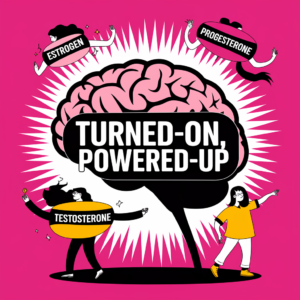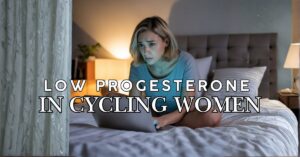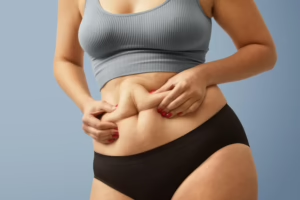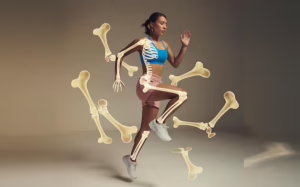You’ve been told to fear fat. The smaller is safer. That thinner means healthier.
But here’s what almost no one is saying: after menopause, that soft curve around your hips might be keeping you from a hospital bed in your 70s.
Women with a BMI under 18.5 are nearly twice as likely to develop osteoporosis as women with moderate body fat, not because of weight alone, but because of estrogen production in adipose tissue. After your ovaries retire, your fat picks up the slack, producing estrone, a milder estrogen that helps protect your bones.
This isn’t theory—it’s biochemistry. And it may be the reason some women can stay upright, mobile, and independent well into their 80s, while others fracture from a simple fall.
But diet culture doesn’t talk about that. It doesn’t tell you that body fat and bone health are deeply connected. Or that the BMI and osteoporosis risk curve is not linear, but inverted.
So if you’re over 45, or already navigating hormonal changes after menopause, this is the science you haven’t heard but need.
You’ll learn:
- Why estrone and bone density are linked in ways that could change how you think about “weight”
- The difference between harmful visceral fat and protective subcutaneous fat
- How to eat, train, and assess your body composition with your skeleton in mind
This article isn’t about permission to ignore health—it’s about replacing myths with biology.
Estrogen and Bones 101—Where the Real Story Begins
Let’s back up a bit. Before menopause, your ovaries are your main source of estradiol, a potent form of estrogen. Think of estradiol as your bone’s project manager. It keeps the construction crews humming, clearing weak spots and laying down fresh material.
But when menopause hits, estradiol production takes a nosedive. And that’s when the trouble begins.
You may have heard the statistic before, but it’s worth repeating: women can lose up to 20% of their bone density in just the first five to seven years after menopause. That’s not abstract. That’s the reason fractures rise. That’s why a seemingly small fall can turn into a life-changing event.
While calcium and vitamin D are important, they are not as effective as estrogen in preventing osteoporosis in postmenopausal women.
So what happens when your ovaries clock out?
Your body doesn’t just surrender. It gets creative.
Your Adipose Tissue: The Unexpected Hormone Lab
Image: Freepik
Enter: body fat—specifically, white adipose tissue.
Once estradiol declines, your fat tissue takes the mic. It starts producing estrone, a gentler form of estrogen, using an enzyme called aromatase. Aromatase converts a hormone called androstenedione (made by your adrenal glands) into estrone. And estrone can bind to estrogen receptors in your bones, helping slow the loss.
This process is known as estrogen production in adipose tissue, and it plays a crucial role in maintaining bone health in aging women.
Think of it this way: if estradiol is your body’s high-octane estrogen, estrone is the hybrid car—less power but much more mileage.
Even better? It’s not just floating around aimlessly. Estrone has two tricks up its sleeve that make it a bone-health superstar.
Estrone’s Hidden Superpowers: What Your Bones Love Most
1. It sticks around for the long haul
Estrone can be converted into estrone sulfate (E1S), a storage form that lingers in the bloodstream. This form acts like a slow-release hormone reserve, staying on standby and springing into action when your body needs more estrogen.
That means your body isn’t just burning through estrogen—it’s stockpiling it, ready to deploy support when your bones are under pressure.
2. It transforms right where it’s needed
Here’s the part that sounds almost magical: your bones can convert estrone sulfate back into estradiol on site. This is thanks to enzymes called 17β-HSDs that live in bone tissue.
This means there’s a direct link between estrone and bone density. Not only does your fat create estrogen, but your bones convert it into precisely what they need, when they need it most.
No pills. No patches. Just biology doing what it was designed to do.
The Fat-Bone Connection
Let’s talk numbers.
Women with a BMI under 18.5 are nearly twice as likely to develop osteoporosis compared to women with a BMI between 24 and 27. Low body weight also correlates with a higher risk of hip fractures, which are among the most debilitating injuries for older adults.
This highlights the BMI and osteoporosis risk that isn’t always discussed. It’s not about vanity—it’s about biology.
Less body fat = less aromatase.
Less aromatase = less estrone.
Less estrone = less hormonal protection for your bones.
But—and this is important—not all fat is created equal.
Visceral fat (the deep belly fat surrounding your organs) is pro-inflammatory and linked to heart disease and metabolic problems. But subcutaneous fat—the soft fat under your skin, especially in the hips and thighs—is different. It’s hormonally protective.
That “junk in the trunk” you’ve been trying to squish into your jeans? It might just be your skeleton’s secret savings account.
Should I Gain Weight Just to Protect My Bones?
Image: Freepik
Short answer? No.
Longer answer? You don’t need to gain weight. But you might need to stop fearing the fat you already have.
This article doesn’t advocate weight gain or unhealthy habits. It’s about recognizing that the soft parts of your body might be quietly doing something essential—keeping your bones strong, your mobility intact, and your independence within reach.
And if you’re actively trying to lose weight after menopause—especially through extreme calorie restriction or low-fat diets—you might be undercutting your body’s hormone production at a critical time.
Instead of “less,” try aiming for “stronger.” Ask questions like:
- Am I eating to support my hormones?
- Do I understand my body composition, not just my weight?
- Am I building and maintaining muscle to support my bones?
Here’s What Supports Bone Health
Want a science-backed game plan to protect your bones? Here’s where to start:
- Get a DEXA scan to assess your bone density baseline, especially after menopause.
- Eat for hormone health: calcium, protein, magnesium, and healthy fats all matter.
- Do resistance training—muscles tug on bones, stimulating growth.
- Talk to your doctor about HRT (hormone replacement therapy) if you have menopausal symptoms or bone loss.
- Track muscle mass and fat distribution, not just BMI. This will give you a clearer view of your long-term strength.
This approach supports bone health in aging women in a grounded, holistic, and sustainable way.
Your Body Knows What It’s Doing
There’s a reason fat production ramps up in women after menopause. It’s not random. It’s your body’s biological insurance policy—a backup hormone lab designed to preserve your bone structure long after your ovaries retire.
That curve in your hip? It might be the reason you don’t break one in your eighties. That softness in your belly? It could be your body’s way of storing extra hormonal fuel for the future.
You’re not broken. You’re brilliantly built, with a body working quietly to protect you, even when the outside world tells you otherwise.
So maybe it’s not about shrinking. Perhaps it’s about finally recognizing the genius in your design.
Want More Science-Backed Aging Advice?
Subscribe to Dr. Amy Killen’s HOT + Longevity for research-based tips on hormones, strength, and vibrant aging. It’s the smarter way to stay strong, savvy, and supported—without the guilt or gimmicks.
Because getting older doesn’t mean giving up. It means leveling up, with your body as your greatest ally.
References
- Heshmati, H.M., Khosla, S., Robins, S.P. and Riggs, B.L., 1995. A possible role of estrone produced in adipose tissues in modulating postmenopausal bone loss. The Journal of Clinical Endocrinology & Metabolism, 80(12), pp.3688–3692. https://doi.org/10.1210/jcem.80.12.8530625
- Muir, M., Romalo, G., Wolf, L., Elger, W. and Schweikert, H.U., 2004. Estrone sulfate is a major source of local estrogen formation in human bone. The Journal of Clinical Endocrinology & Metabolism, 89(9), pp.4685–4692. https://doi.org/10.1210/jc.2004-0049
- Lindsay, R., Hart, D.M. and Clark, D.M., 1990. The minimum effective dose of estrogen for prevention of postmenopausal bone loss. Obstetrics & Gynecology, 75(6), pp.1065–1069. PMID: 2188184
- Hadji, P., Gnant, M. and Body, J.J., 2019. Fat body mass, vertebral fractures, and aromatase inhibitor therapy. JAMA Network Open, 2(9). https://doi.org/10.1001/jamanetworkopen.2019.11181
- Yaffe, K., Sawaya, G., Lieberburg, I. and Grady, D., 1997. Estrogen therapy in postmenopausal women: Effects on cognitive function and dementia. JAMA, 278(12), pp.1017–1021. https://doi.org/10.1001/jama.1997.03550120081041
- Wise, P.M., Dubal, D.B., Wilson, M.E., Rau, S.W. and Böttner, M., 2001. Neuroprotective effects of estrogen—New insights into mechanisms of action. Endocrinology, 142(3), pp.969–973. https://doi.org/10.1210/endo.142.3.8033
- Daniel, J.M. and Bohacek, J., 2023. Cardiometabolic health, menopausal estrogen therapy, and the brain. Cells, 12(4). https://doi.org/10.3390/cells12040606
- Marshall, G.A., Rentz, D.M., Frey, M.T., Locascio, J.J. and Johnson, K.A., 2017. Being too thin late in life tied to increased Alzheimer’s risk. Journal of Alzheimer’s Disease, 57(3), pp.829–838. https://doi.org/10.3233/JAD-161089
- Yaffe, K., Haan, M., Byers, A., Tangen, C. and Kuller, L., 2011. Estrogen therapy’s link with dementia risk depends on age when taken. JAMA, 305(9), pp.935–937. https://doi.org/10.1001/jama.2011.243
- Silva, T.R., Spritzer, P.M. and Maranhão, P.A., 2012. Long-term prospective study of the influence of estrone levels on coronary artery disease mortality. Journal of Clinical Medicine Research, 4(3), pp.184–190. https://doi.org/10.4021/jocmr890w
- Zhang, D., Zhang, L., Xu, X., Wang, T. and Zheng, Y., 2021. Protective effects of estrogen on cardiovascular disease mediated by oxidative stress. Oxidative Medicine and Cellular Longevity. https://doi.org/10.1155/2021/5523516
- Nudy, M., Santoro, N. and Neal-Perry, G., 2025. Long-term hormone therapy and cardiovascular health in menopausal women. Obstetrics & Gynecology. https://doi.org/10.1097/AOG.0000000000000000
- Faulkner, J. and Belin de Chantemele, E., 2018. Obesity and cardiovascular risk in premenopausal women. Circulation Research. https://doi.org/10.1161/CIRCRESAHA.118.312734
- Reis, S.E., Holubkov, R., Zell, K.A., Smith, A.J. and Kelsey, S.F., 1996. Cardiovascular effects of estrogen and lipid-lowering therapies in postmenopausal women. Circulation, 93(10), pp.1928–1937. https://doi.org/10.1161/01.CIR.93.10.1928
- Compston, J.E., Watts, N.B., Chapurlat, R., Cooper, C., Boonen, S., Greenspan, S., Pfeilschifter, J., Silverman, S., Papapoulos, S., Meunier, P.J. and Lindsay, R., 2011. Risk factors for nonvertebral fracture in obese older women. The Journal of Clinical Endocrinology & Metabolism, 96(8), pp.2414–2421. https://doi.org/10.1210/jc.2011-0076
- Turcotte, A.F., Morissette, M., Gaudreault, V. and Carpentier, A.C., 2022. Obesity linked to higher risk of broken bones in women. European Association for the Study of Obesity. https://easo.org/obesity-linked-to-higher-risk-of-broken-bones-in-women/
- Lin, Y.K., Lee, C.H., Wu, L.W., Lin, C.L. and Kao, C.H., 2024. The association between body mass index and osteoporosis in a Taiwanese cohort. Scientific Reports, 14(1). https://doi.org/10.1038/s41598-024-59159-4
- Karjalainen, M.K., Silvennoinen, K., Autio, V., Järvinen, T.L.N., Nieminen, M.T. and Rissanen, A., 2020. Obesity is associated with early hip fracture risk in postmenopausal women. Osteoporosis International, 32(3), pp.509–517. https://doi.org/10.1007/s00198-020-05642-3
- Toraldo, G., Vitali, E., Nappi, R.E. and Bianchi, M., 2023. The role of testosterone and estrone in bone health and fracture risk in postmenopausal women. Endocrine Society. Available at: https://www.hcplive.com/view/testosterone-estrone-bone-health-fracture-risk-postmenopausal-women
Nørgaard, M., Johnsen, S.P., Pedersen, L. and Sørensen, H.T., 2024. Dementia in women using estrogen-only therapy. JAMA, 331(2), pp.143–151. https://doi.org/10.1001/jama.2023.26366

